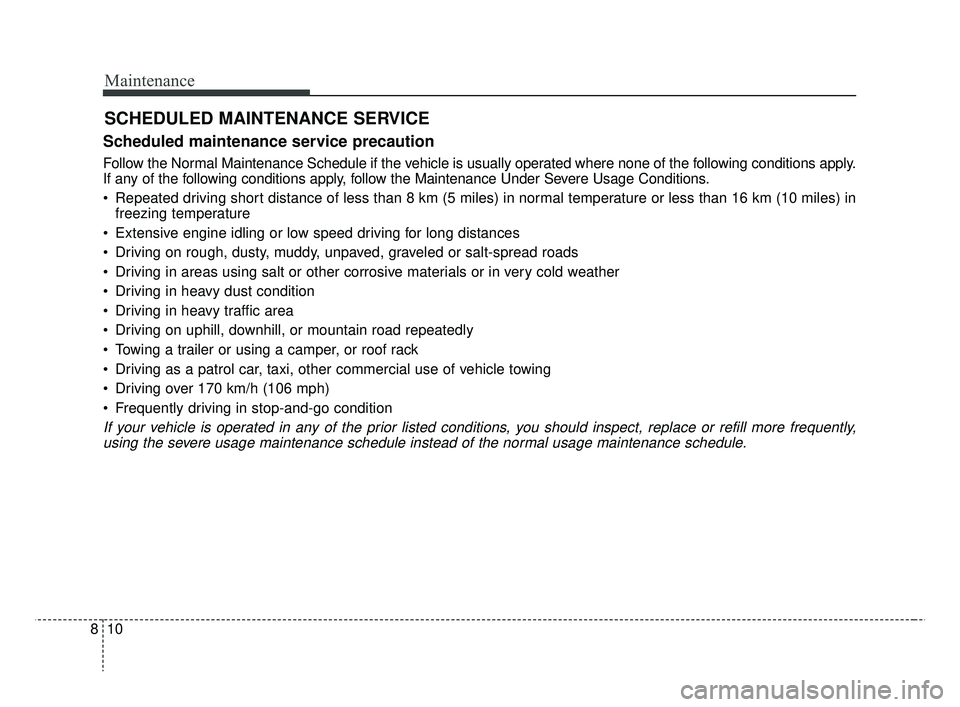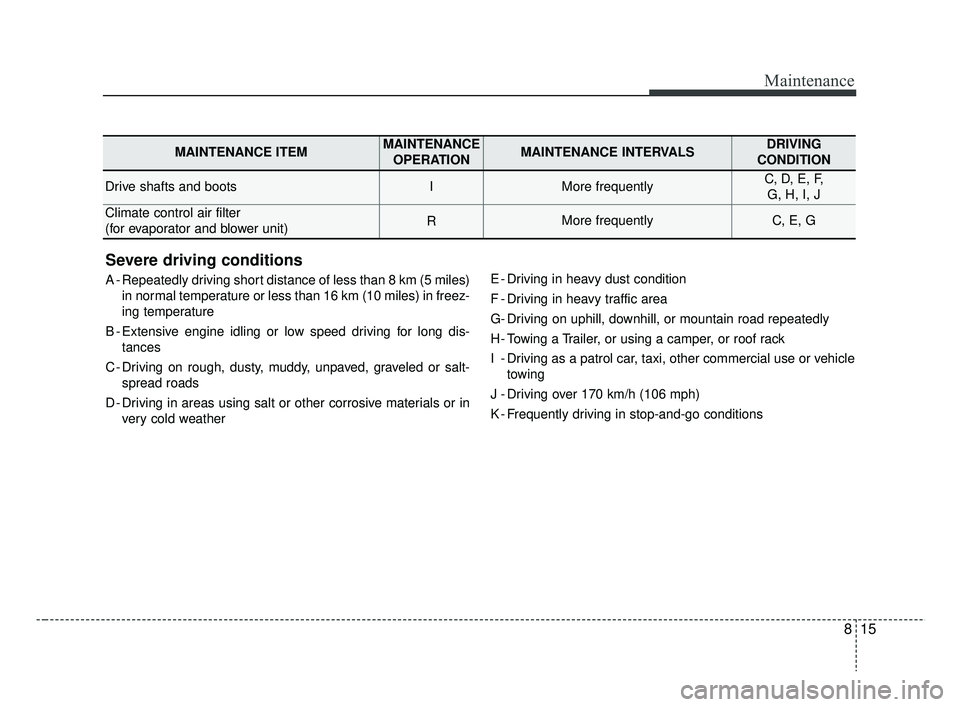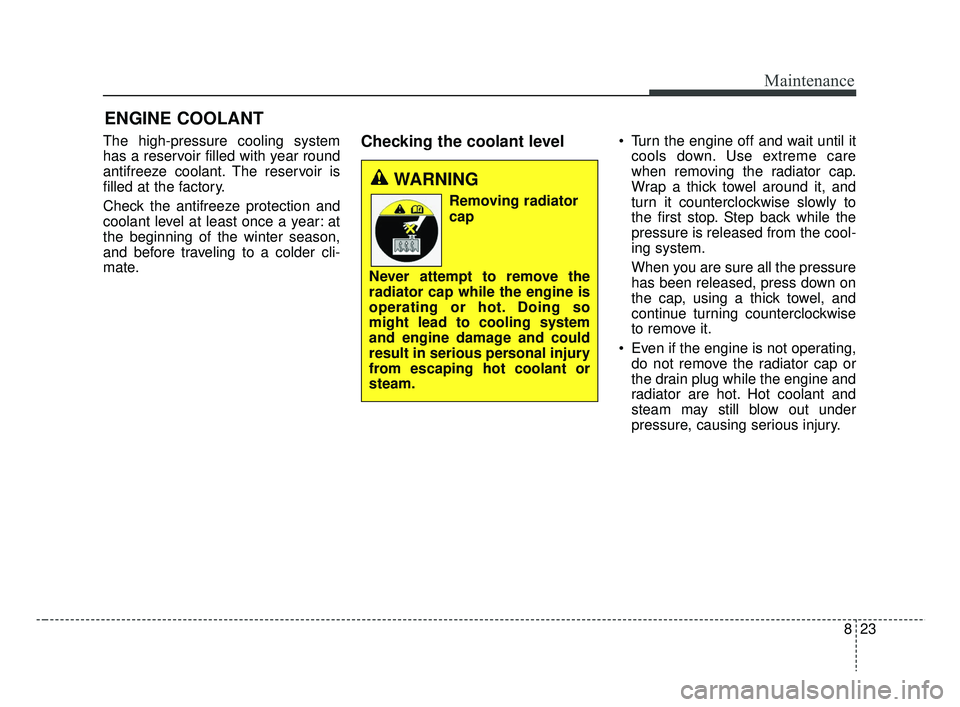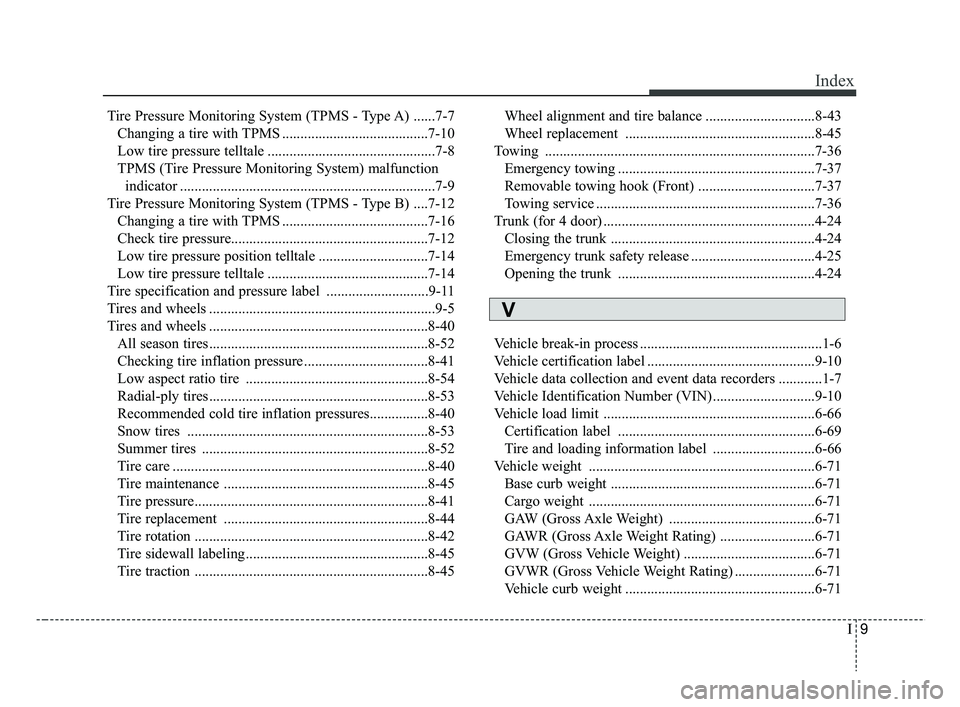Page 382 of 503

Maintenance
10
8
SCHEDULED MAINTENANCE SERVICE
Scheduled maintenance service precaution
Follow the Normal Maintenance Schedule if the vehicle is usually operated where none of the following conditions apply.
If any of the following conditions apply, follow the Maintenance Under Severe Usage Conditions.
• Repeated driving short distance of less than 8 km (5 miles) in normal temperature or less than 16 km (10 miles) in
freezing temperature
Extensive engine idling or low speed driving for long distances
Driving on rough, dusty, muddy, unpaved, graveled or salt-spread roads
Driving in areas using salt or other corrosive materials or in very cold weather
Driving in heavy dust condition
Driving in heavy traffic area
Driving on uphill, downhill, or mountain road repeatedly
Towing a trailer or using a camper, or roof rack
Driving as a patrol car, taxi, other commercial use of vehicle towing
Driving over 170 km/h (106 mph)
Frequently driving in stop-and-go condition
If your vehicle is operated in any of the prior listed conditions, you should inspect, replace or refill more frequently, using the severe usage maintenance schedule instead of the normal usage maintenance schedule.
SC CAN (ENG) 8.qxp 8/3/2018 5:46 PM Page 10
Page 387 of 503

815
Maintenance
Severe driving conditions
A - Repeatedly driving short distance of less than 8 km (5 miles)in normal temperature or less than 16 km (10 miles) in freez-
ing temperature
B - Extensive engine idling or low speed driving for long dis- tances
C - Driving on rough, dusty, muddy, unpaved, graveled or salt- spread roads
D - Driving in areas using salt or other corrosive materials or in very cold weather E - Driving in heavy dust condition
F - Driving in heavy traffic area
G- Driving on uphill, downhill, or mountain road repeatedly
H - Towing a Trailer, or using a camper, or roof rack
I - Driving as a patrol car, taxi, other commercial use or vehicle
towing
J - Driving over 170 km/h (106 mph)
K - Frequently driving in stop-and-go conditions
MAINTENANCE ITEMMAINTENANCE OPERATIONMAINTENANCE INTERVALSDRIVING
CONDITION
Drive shafts and bootsIMore frequentlyC, D, E, F, G, H, I, J
Climate control air filter
(for evaporator and blower unit)RMore frequentlyC, E, G
SC CAN (ENG) 8.qxp 7/18/2018 5:32 PM Page 15
Page 395 of 503

823
Maintenance
ENGINE COOLANT
The high-pressure cooling system
has a reservoir filled with year round
antifreeze coolant. The reservoir is
filled at the factory.
Check the antifreeze protection and
coolant level at least once a year: at
the beginning of the winter season,
and before traveling to a colder cli-
mate.Checking the coolant level Turn the engine off and wait until itcools down. Use extreme care
when removing the radiator cap.
Wrap a thick towel around it, and
turn it counterclockwise slowly to
the first stop. Step back while the
pressure is released from the cool-
ing system.
When you are sure all the pressure
has been released, press down on
the cap, using a thick towel, and
continue turning counterclockwise
to remove it.
Even if the engine is not operating, do not remove the radiator cap or
the drain plug while the engine and
radiator are hot. Hot coolant and
steam may still blow out under
pressure, causing serious injury.
WARNING
Removing radiator
cap
Never attempt to remove the
radiator cap while the engine is
operating or hot. Doing so
might lead to cooling system
and engine damage and could
result in serious personal injury
from escaping hot coolant or
steam.
SC CAN (ENG) 8.qxp 7/18/2018 5:33 PM Page 23
Page 502 of 503

I9
Index
Tire Pressure Monitoring System (TPMS - Type A) ......7-7Changing a tire with TPMS ........................................7-10
Low tire pressure telltale ..............................................7-8
TPMS (Tire Pressure Monitoring System) malfunction indicator ......................................................................7-\
9
Tire Pressure Monitoring System (TPMS - Type B) ....7-12 Changing a tire with TPMS ........................................7-16
Check tire pressure.....................................................\
.7-12
Low tire pressure position telltale ..............................7-14
Low tire pressure telltale ............................................7-14
Tire specification and pressure label ............................9-11
Tires and wheels ..............................................................9-5
Tires and wheels ............................................................8-40 All season tires ............................................................8-52
Checking tire inflation pressure ..................................8-41
Low aspect ratio tire ..................................................8-54
Radial-ply tires ............................................................8-53
Recommended cold tire inflation pressures................8-40
Snow tires ..................................................................8-53
Summer tires ..............................................................8-52
Tire care ......................................................................8-\
40
Tire maintenance ........................................................8-45
Tire pressure................................................................8-41
Tire replacement ........................................................8-44
Tire rotation ................................................................8-42
Tire sidewall labeling..................................................8-45
Tire traction ................................................................8-45 Wheel alignment and tire balance ..............................8-43
Wheel replacement ....................................................8-45
Towing ........................................................................\
..7-36 Emergency towing ......................................................7-37
Removable towing hook (Front) ................................7-37
Towing service ............................................................7-36
Trunk (for 4 door) ..........................................................4-24 Closing the trunk ........................................................4-24
Emergency trunk safety release ..................................4-25
Opening the trunk ......................................................4-24
Vehicle break-in process ..................................................1-6
Vehicle certification label ..............................................9-10
Vehicle data collection and event data recorders ............1-7
Vehicle Identification Number (VIN)............................9-10
Vehicle load limit ..........................................................6-66 Certification label ......................................................6-69
Tire and loading information label ............................6-66
Vehicle weight ..............................................................6-71 Base curb weight ........................................................6-71
Cargo weight ..............................................................6-71
GAW (Gross Axle Weight) ........................................6-71
GAWR (Gross Axle Weight Rating) ..........................6-71
GVW (Gross Vehicle Weight) ....................................6-71
GVWR (Gross Vehicle Weight Rating) ......................6-71
Vehicle curb weight ....................................................6-71
V
SC CAN (ENG) Index.qxp 7/18/2018 5:31 PM Page 9